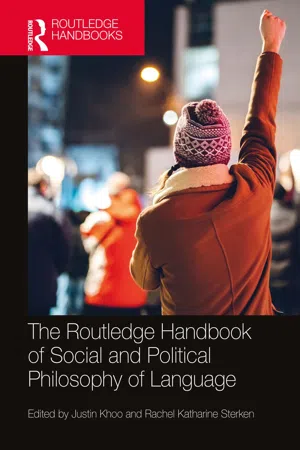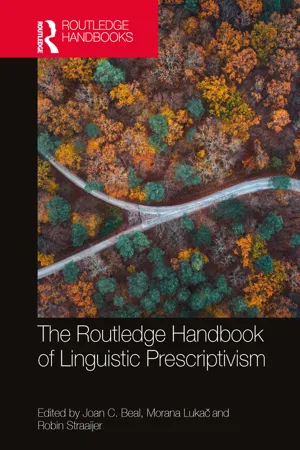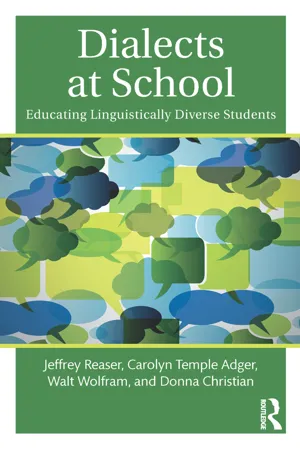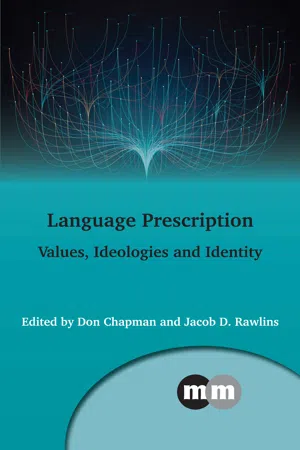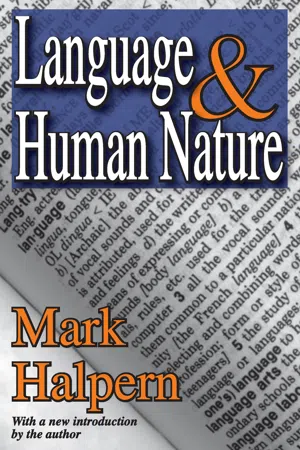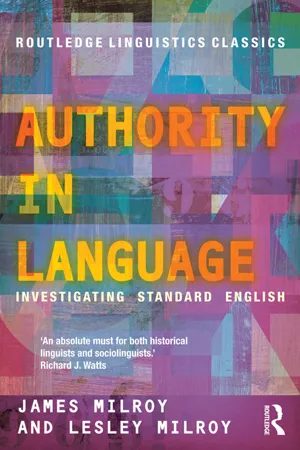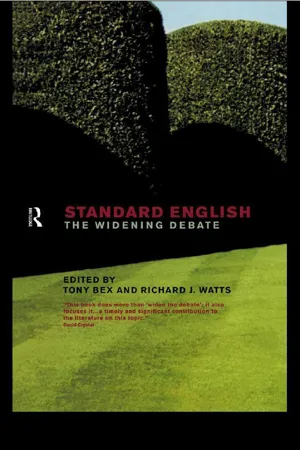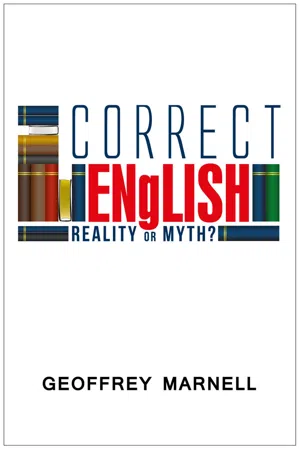Languages & Linguistics
Prescriptivism
Prescriptivism is an approach to language that emphasizes adherence to established rules and standards. It often involves prescribing how language should be used based on traditional norms and conventions. This can include advocating for certain grammar, vocabulary, and pronunciation rules, and is often contrasted with descriptivism, which focuses on describing how language is actually used.
Written by Perlego with AI-assistance
Related key terms
9 Key excerpts on "Prescriptivism"
- Justin Khoo, Rachel Katharine Sterken, Justin Khoo, Rachel Katharine Sterken(Authors)
- 2021(Publication Date)
- Routledge(Publisher)
thesis , one it will be instructive to evaluate philosophically but in any case one that serves as a marker of the “prescriptivist” side of this heated dispute. Let’s call this posited thesis “Linguistic Prescriptivism” (big L, big P). We now canvas a series of possible statements of it. As per our ongoing strategy, we begin with something not especially promising:Linguistic Prescriptivism 1 : There are norms governing language use, and they should be followed.In favour of this, prescriptivists will at least recognize themselves as advocates of it. That is a step up from where we were heading in Section 2 . Unfortunately, both in common parlance and when it is being poopooed by linguistically informed academics, our target thesis cannot amount merely to “There’s a way language should be used”. Just about everyone (rightly, we suggest) agrees to the applicability of a wide range of norms on language use. These include a moral prohibition on at least some out of: lying, insinuating known falsehoods, speaking out of ignorance, ad hominem attacks, unwarranted rudeness, propaganda, bullshit, coercion, linguistic oppression, gratuitous insults, hate speech, and inciting genocidal violence. They also include the conversational norms without which linguistic exchange would be vastly more challenging, such as Grice’s “be relevant” (1989), or proscriptions on defective concepts.Perhaps what sets prescriptivists apart is a more specific concern with the choice of linguistic “vehicle” (the wrong word, the wrong spelling, the wrong grammar, etc.) to express a given content. This yields:Linguistic Prescriptivism 2 : There are norms governing not just what things you say but how you say them; these norms should be followed.This captures the bugbears. Nonetheless, it is still far too wide. There are many attitudes to language use that fit this definition without constituting what we would ordinarily call “Prescriptivism”.Some word choices, for example, are resisted as very generally offensive by all reasonable parties and not only by prescriptivists. Slurring words come immediately to mind. Following Diaz-Legaspe et al. (2019), we take these to have the same propositional content as their neutral correlates: begging pardon for the nasty term, “chink” and “Chinese person” are true of the same set of individuals. The difference is a matter of sociolinguistic register: slurring words are typically marked as [+ vulgar, − polite, + derogatory], whereas their counterparts are not. By our lights, then, what is said with a slurring term need not be disrespectful, but how it is said will always be, setting aside the notorious problem cases of re-appropriation and mention. A non-prescriptivist can also hold that certain other forms of language are vaguely wrong most of the time, albeit not morally so: impressive sounding but obscure or vague terms, for example. Some forms of language are arguably simply unattractive, such as repetitive phrasing, cliché, and “management-speak”. A non-prescriptivist can surely lament, as violations of good style, these “ways of saying it”.4- Joan C. Beal, Morana Lukač, Robin Straaijer, Joan C. Beal, Morana Luka?, Robin Straaijer(Authors)
- 2023(Publication Date)
- Routledge(Publisher)
A few have provided overviews that solely focus on Prescriptivism, such as Anne Curzan’s Fixing English: Prescriptivism and Language History (Curzan, 2014) and Ingrid Tieken-Boon van Ostade’s Describing Prescriptivism: Usage Guides and Usage Problems in British and American English (Tieken-Boon van Ostade, 1019). The most renowned works in the field provide accounts of Prescriptivism in the context of language standardization/language ideology, including James and Lesley Milroy’s Authority in Language: Investigating Language Prescription and Standardisation (Milroy & Milroy, 2012 [1985]), or investigate it as a social phenomenon, as do Deborah Cameron’s Verbal Hygiene (Cameron, 2012 [1995]), Rosina Lippi-Green’s English with an Accent (Lippi-Green, 2012), Richard Watts’s Language Myths and the History of English (Watts, 2011) and Lynda Mugglestone’s “Talking Proper”: The Rise of accent as a Social Symbol (Mugglestone, 2007 [1995]). In other languages, the topic of Prescriptivism has been included in monographs and several collections on standardizing attitudes to particular languages have been published recently- eBook - ePub
Language and Nationality
Social Inferences, Cultural Differences, and Linguistic Misconceptions
- Pietro Bortone(Author)
- 2021(Publication Date)
- Bloomsbury Academic(Publisher)
A descriptive grammar of x are usually seeking a kind of instruction and guidance that is fundamentally prescriptive. And ultimately, even urging people to speak their ‘natural’ vernacular, and encouraging them to avoid ‘prescriptive’ styles, entails being prescriptive.Language normativity is definitely, in many ways, illiberal; but language is anyway based on the development and partial maintenance of rules and norms – an important point elaborated by Cameron (2012: 2–3). Language is made of socially selected rules, in its structure as much as in its pragmatics. Therefore corrections, disapproval, and value judgments of other people’s (and one’s own) usage are also part of language use, not just of a particular prescriptivist approach. Almost everybody has opinions as to what is linguistically ‘better’ – because they deem it clearer, appropriate to the occasion, or somehow more beautiful. Indeed, diachronic change in language, as we mentioned before, is partly due to social attitudes and social changes.Imposing whose standard?An important positive aspect of the standardization of languages that must be noted is that, in several cases, the language variety that was elevated to the role of the national standard was a variety much closer to the people’s spoken language than the archaic or foreign language previously used as official and written medium. In those cases, the creation of such national standard was an altogether democratic step. However, the living language or dialect that gets elevated to national standard is sometimes not the most common among the population, and is selected for ideological reasons. For example, at the time of the foundation of the state of Pakistan in 1947, Urdu was spoken by a minority, but was chosen over languages with many more millions of speakers because Urdu fitted a distinctly Muslim identity for the new state (Simpson 2007: 8). Above all, a standard language is very commonly correlated, indeed doubly correlated, with social class. It is, recursively, both a cause of social hierarchies and a consequence - eBook - ePub
Dialects at School
Educating Linguistically Diverse Students
- Jeffrey Reaser, Carolyn Temple Adger, Walt Wolfram, Donna Christian(Authors)
- 2017(Publication Date)
- Routledge(Publisher)
p. 11Many teachers naturally embrace the rhetorically correct perspective in reviewing student writing, allowing students to use more informal language on certain assignments, such as journals or creative writing, though they may still enforce their prescriptive pet peeves. However, when it comes to the oral language students use in the classroom, teachers may be less accepting of certain variants, enforcing prescriptive norms even during moments of informal communication. In elementary schools, it is not uncommon to hear a teacher respond to a child who has asked, “Can I go to the bathroom?” with “I don’t know, can you?” Such a response ignores the fact that the student’s language was rhetorically appropriate even if it was prescriptively incorrect.Anne Curzan’s (2014) analysis of Prescriptivism is the most complete treatment of that approach by a linguist. She uses a metaphor of language as a river in order to capture more nuanced ways that Prescriptivism affects language development. She suggests that linguists often frame Prescriptivism as “ the attempt to construct a dam that will stop the river in its tracks” (p. 4). Linguists argue that since the dam (Prescriptivism) cannot fully stop the flow of the river (language change), the dam (Prescriptivism) must be ineffective. She suggests that it is better to evaluate Prescriptivism according to what it does to the flow of the river: “It becomes easier to see how Prescriptivism may be able to affect how the language changes . . . the sheer presence of the dam affects the flow of the river” (Curzan, 2014, p. 4). Though prescriptive forces—including teachers and other educational personnel and institutions—lack the ability to stop language change, they are influential in shaping the current of changes to the language.In order to separate out the various goals, actors, and effects of Prescriptivism, Curzan divides it into four non-discrete strands, offering a useful framework for thinking about language standards. The first strand, standardizing Prescriptivism, is like traffic laws: It attempts to codify rules to ensure easy communication among speakers of a language. The most successful example of standardizing Prescriptivism for English is in spelling standardization, which had been completed (more or less) by the end of the eighteenth century. Less successful examples of standardizing Prescriptivism result in language stigmas, such as that associated with the word ain’t and with certain dialect pronunciations, such as aks for ask - eBook - ePub
Language Prescription
Values, Ideologies and Identity
- Don Chapman, Jacob D. Rawlins(Authors)
- 2020(Publication Date)
- Multilingual Matters(Publisher)
Despite these textbook examples of the supposed futility of Prescriptivism, anti-prescriptivists underestimate both the average person’s ability to resist control by linguistic means, and the desire for a degree of regimentation of language. Anti-Prescriptivism has the admirable social-political motive of wanting to ignore or reject how language functions to establish social relations and social coherence. Anti-prescriptivists recoil from recognizing and tacitly endorsing hierarchies where speakers get judged in terms of intelligence, morality, etc. based on how they speak, when this is not something within the speaker’s power to change – a contentious point, to which I shall return. However they are also prone to convincing themselves that utterances, as long as they are grammatical, generate their own interpretation, which is identical with the utterer’s intention, à la Chomsky (1964). That conviction is the basis for Pullum’s insistence that the rules he formulates are purely descriptive. No ifs, ands or buts. Anyone who might take them as prescriptive is engaging in deviance.Proposition 5: Anti-Prescriptivism is Bound up with Incuriosity about How Languages are Formed, Changed and Maintained in their VariabilityLinguists are surprisingly ready to accept an idealized view that languages somehow ‘naturally’ coalesce, and incurious about the processes and institutions by which they do so. This is a critique that I have been making since Joseph (1981, 1987), and it is heartening to see a growing number of linguists doing excellent research into documentary sources that reveal details about how particular languages were standardized in printing, in legal chanceries and especially in educational institutions (see, for example, Curzan, 2014; Hickey, 2012; Percy & Davidson, 2012; Rutten, 2016; Rutten et al. , 2014; Tieken-Boon van Ostade & Percy, 2016). But all of us are well aware that ours is still a minority interest within the field.The mainstream view is embodied in Pullum’s use of ‘constitutive’ and ‘regulative’ rules. He never brings up the status of the constitutive rules, how they come about, spread, change or are maintained. Most of the time we let ourselves imagine that the needs of ‘communication’ somehow keep variability in check, when the history of every language for which there is documentation suggests that deliberate interventions have gone into making them what they are and are not. Languages, like nations, are ‘imagined communities’ (Anderson, 1983), whose coherence has to be invented and then constantly maintained. A key component of this process is forgetting that they were invented, so that they instead appear primordial and natural. Prescription is the ongoing trace of these interventionist processes. We have much to learn from examining the continuity between standard language and language tout court - eBook - ePub
- Mark Halpern(Author)
- 2017(Publication Date)
- Routledge(Publisher)
should turn out, no one can say with any authority; and since there is no natural course with which to interfere, there is nothing that can properly be called an interference; ‘interferences’ are simply what linguistic scientists call those events of linguistic history that they cannot accept.The title ‘descriptivist’ raises a problem that has been often noted, but to which the people who so describe themselves have never offered a reasoned reply: descriptivists, as their name indicates, profess simply to be describing the language and the various forces acting upon it, and Prescriptivism is one of those forces — so why is it, and it alone, to be disallowed? The practitioners of linguistic science cannot reasonably quarrel with prescriptivists any more than they do with ghetto youths; like those youths, we are their data. The explanation of this anomaly is that linguists are in the grip of a delusion: they think, as aspirants to the title of ‘scientist’ must, that they are investigating a branch of nature rather than an artifact. Given this false premise, it follows that prescriptivists, in trying to guide language usage, are interfering with a phenomenon under scientific investigation, just as someone secretly slipping peanuts to laboratory chimps would be compromising an investigation into their metabolism.It is instructive to observe that those who pride themselves on being pure descriptivists, standing neutral above all usage battles, recording the facts they find without bias, and searching for the laws of linguistic nature, should take issue with the prescriptivists when they do so with no one else. Why do the grossest offenses against cultivated speech or writing arouse in the linguists no emotion, but only scientific interest, when other linguistic phenomena — the strictures of a John Simon, for example — arouse their passions to the point where even so civilized a man as Nunberg sounds as if he’d like to have Simon whipped? Nunberg’s view, I think, is this (what follows are my words, not his): - eBook - ePub
Authority in Language
Investigating Standard English
- James Milroy, Lesley Milroy(Authors)
- 2012(Publication Date)
- Routledge(Publisher)
8 SOME PRACTICAL IMPLICATIONS OF Prescriptivism Educational issues and language assessment procedures8.1 IntroductionThroughout this book, we have considered linguistic Prescriptivism from two perspectives. First, we have looked at popular and general notions of correctness in language in relation to known facts about linguistic structure and use. Second, practical questions have been discussed as they emerged, particularly questions of interest to educators. Generally, we have argued that objective and disinterested discussion of important practical issues connected with ‘correctness’ (such as the problems of non-standard speakers in the educational system) has been rare, with the result that language teaching and assessment procedures are often less effi cient than they might otherwise be.We now consider in a little more detail two practical matters related to language teaching and assessment, areas of activity where an objective and informed approach to the facts of language structure and language use would seem to be especially important. The fi rst is the extensive debate which has been particularly prominent in the British press over the last ten years on the nature of the English language curriculum. The second is the manner in which language tests are used to measure, for various purposes, the linguistic abilities of an individual. This latter discussion is not confi ned to Britain, nor to educational contexts.8.2 Press, politicians and the great grammar debateLike most other contemporary states, Britain has a majority of non-standard speakers in the school population. Even within such a relatively small area as the European Community, some governments have responded to the democratisation of education with more enthusiasm than others, as is evident from the widely diff ering perspectives on education of non-standard dialect speakers described by Cheshire et al - eBook - ePub
Standard English
The Widening Debate
- Tony Bex, Richard J. Watts(Authors)
- 2002(Publication Date)
- Routledge(Publisher)
Harris 1987 :112). It is thus easy to see how the Victorian case for Prescriptivism became indistinguishable from the case for standardisation.Muddling speech and writing
Related to the notion of the fixed-code theory and the reaction against Prescriptivism is the idea that speech is the primary concern of the linguist. Writing is said, by the majority of linguists, to hold a merely derivative function. But in the absence of any way of codifying language, such as writing, the idea of any standard of language would collapse.For the majority of present-day linguists, speech has primacy over writing: ‘speech is prior to writing not only historically but also genetically and logically’ (Bolinger and Sears 1981 :274). Lyons (1972) spells this out in greater detail, advancing arguments that have a tradition dating back to the nineteenth century in language study, a tradition which, although antedating the sound spectrograph, was reacting against the non-scientific Prescriptivism according to which the written language of certain authors embodied ‘correct’ language. This reaction against writing in part explains why some theorists wish to deny that writing is language (Bloomfield 1935 :21). Lyons claims that the spoken language is prior to the written ‘in the sense that the latter results from the transference of the former from its “natural”, or primary, medium to a secondary medium’ (Lyons 1972 - eBook - ePub
Correct English
Reality or Myth?
- Geoffrey Marnell(Author)
- 2015(Publication Date)
- Burdock Books(Publisher)
Were it not for the contribution of Chomsky’s “pragmatic considerations”, universalists would have difficulty accounting for the contemporary and historical variations in a language: current American English differs from current British English, which differs from Elizabethan English, and so on. For Chomsky the surface features of a language are not innate and thus cannot be universal. Yet it is the surface features of English—such as the placement of apostrophes and the unity of infinitives—that mostly worry prescriptivists.Chomsky makes a further distinction between competence —being able to express ourselves according to biological determinants—and performance : being able to use our innately-guided language well (Chomsky 2006, p. 102). This distinction is another barrier to any attempt to justify Prescriptivism by the existence of universal grammar. Universal grammar is concerned with competence; Prescriptivism is concerned with performance. So long as one has normal brain and body function, one will develop language competence, but that’s as far as biology and psychology goes. The way we use our language is instead culturally determined. Useful parallels are not hard to find. Take the human eye. It can only discern colour differences to a limited degree. That is a universal structural limitation on human perception. But that in no way limits visual artists to any particular style of painting or any particular palette of colours. Pointillism, for instance, cannot be dismissed as non-art because (let us imagine) it breaks some universal law about human perception. Or consider music. If we assume—erroneously—that all music is limited to the eleven semitones of the chromatic scale in each octave, does that in any way place boundaries on the style of music that can be composed? Stravinsky used the same chromatic scales as Bach, but the musical styles of these two undeniably great composers are quite unlike.To sum up: universal grammar does not bolster the case for Prescriptivism. Even if there are biological and psychological limitations to language capacity, the way we use that capacity is up to us. There is freedom within determinism.Etymological purity should be preservedTo many prescriptivists, the spelling of a word should reflect its ancestry. For them it is wrong for a spelling not to, and some crusty old favourites—such as H. W. Fowler or the Oxford English Dictionary —are wheeled out in support of this view. An example is the argument against the -ise spellings of words like authorise and colonise . The following quote from the Oxford English Dictionary
Index pages curate the most relevant extracts from our library of academic textbooks. They’ve been created using an in-house natural language model (NLM), each adding context and meaning to key research topics.
